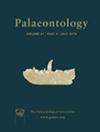An efficient method for estimating vein density of Glossopteris and its application
IF 2.3
2区 地球科学
Q1 PALEONTOLOGY
引用次数: 0
Abstract
Glossopteris‐type leaves are the most abundant floristic element from the Gondwanan continent and are recorded throughout the Permian, which was a period of extreme icehouse‐to‐hothouse climatic global change. Fossil leaf traits can be useful for the reconstruction of palaeoenvironments and identification of climatic changes throughout geological time, but the conservative morphology of Glossopteris leaves has thus far made them difficult to use for this purpose. If the characters of Glossopteris can be better quantified then it should make them useful for tracking environmental changes over a wide geographical area and over a long time interval. Venation density is a highly variable leaf trait that might be useful for this purpose. This trait can be calculated, usually as vein length per centimetre squared, but this can be a time‐consuming procedure. In this paper we propose a new rapid method to estimate venation density in a conical sector of Glossopteris leaf lamina using an accurate linear model whose predictors are three linear venation densities, measured as veins per centimetre. In addition to substantially reducing the data collection time, it is less biased and more reproducible than methods applied previously with this leaf type. Using this more robust method, preliminary results significantly distinguish the venation densities of leaves produced in wet and drier ecosystems, matching a pattern similar to modern plants. This is the first survey using a large sample size to reveal that environmental stress controlled the vein architecture of Palaeozoic plants, in a manner similar to plants in modern ecosystems.一种估算舌肌静脉密度的有效方法及其应用
舌蕨类型的叶子是冈瓦纳大陆最丰富的植物区系元素,在整个二叠纪时期都有记录,这是一个全球气候从冰库到温室的极端变化时期。化石叶片特征可用于古环境的重建和整个地质时期气候变化的鉴定,但迄今为止,由于舌蕨叶片的保守形态,使其难以用于这一目的。如果词汇表的特征可以更好地量化,那么它应该有助于在广泛的地理区域和长时间间隔内跟踪环境变化。脉脉密度是一个高度可变的叶片性状,可能对这一目的有用。这种特征可以计算,通常为每平方厘米的静脉长度,但这可能是一个耗时的过程。在本文中,我们提出了一种新的快速方法来估计叶面的圆锥形扇形脉密度使用一个精确的线性模型,其预测是三个线性脉密度,测量为每厘米脉。除了大大减少数据收集时间外,它比以前使用这种叶片类型的方法偏差更小,可重复性更高。使用这种更可靠的方法,初步结果显着区分了潮湿和干燥生态系统中产生的叶片的脉脉密度,与现代植物的模式相似。这是第一次使用大样本揭示环境压力控制古生代植物脉结构的调查,其方式与现代生态系统中的植物相似。
本文章由计算机程序翻译,如有差异,请以英文原文为准。
求助全文
约1分钟内获得全文
求助全文
来源期刊

Palaeontology
地学-古生物学
CiteScore
5.60
自引率
3.80%
发文量
43
审稿时长
6 months
期刊介绍:
Palaeontology publishes a wide variety of papers on palaeontological topics covering:
palaeozoology
palaeobotany
systematic studies
palaeoecology
micropalaeontology
palaeobiogeography
functional morphology
stratigraphy
taxonomy
taphonomy
palaeoenvironmental reconstruction
palaeoclimate analysis and biomineralization studies.
 求助内容:
求助内容: 应助结果提醒方式:
应助结果提醒方式:


